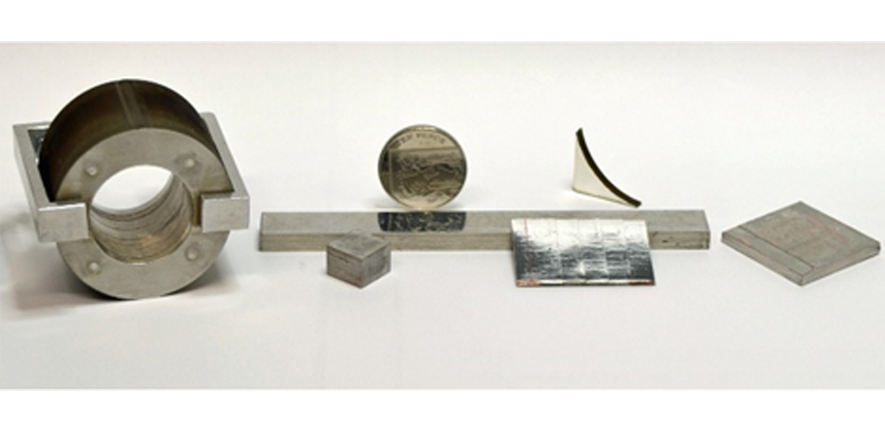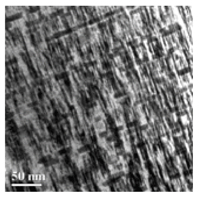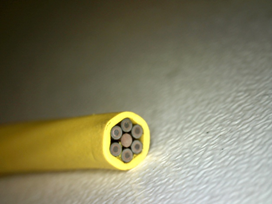
Banner image: Selection of HTS tape stacks created by the Applied Superconductivity and Cryoscience Group.
We work on a range of superconducting materials, ranging from metallic thin films for device applications, to tapes and bulk materials for motors and other applications.
A range of metallic thin film with critical temperatures below 10 kelvin are grown by ultra-high vacuum sputter deposition: examples are Nb, Al and amorphous MoSi. We also grow NbN which has a somewhat higher critical temperature and is compatible with other nitride materials.

In particular, the Driscoll group are working on 2 aspects of superconductivity. The first one is quite applied and the second more fundamental. The first is on improving pinning in rapidly-grown (liquid-assisted) coated conductors of REBCO-based superconductors. This work is very important for getting high performance, cost-effective superconductors into the market place and will impact on applications such as SMES, LHC coils, motors, generators and NMR. The work is in collaboration with Applied Materials (US) and Sunam (Korea). The second area is on novel 3D strain nanoegineering of La2CuO4 to increase its Tc beyond the highest Tc observed in single layer cuprates. This work has both practical significance and may also help shed light on the superconducting mechanism of cuprates.
Image to the right shows a cross-sectional TEM of an YBCO superconductor thin film with nanocolumns of pinning addition (Nb+Ta double perovskite) embedded within it. The nanocolumns act as very effective magnetic flux pinning centres.
Superconducting conductors for applications
Development research includes the design and fabrication of advanced superconductors, and their characterization and optimization, for applications including high-resolution MRI, NMR, fusion, energy storage and fault current limiters in collaboration with SIEMENS.

Figure caption: Cryostabilised 6 x MgB2 conductor manufactured by ASCG for MRI magnet applications [IEEE TRANSACTIONS ON APPLIED SUPERCONDUCTIVITY, VOL. 26, NO. 3, APRIL 2016]
Materials under investigation span the entire Tc range, including REBa2Cu3O7, MgB2. We are developing advanced multi-ceramic ink-jet printing of 3D multifilamentary magnetic-superconducting heterostructures with nanosize artificial pinning centres, to reduce hysteretic AC losses in high-current coated conductors in collaboration with BASF. Our innovative, pulsed transport current (4 kA) and magnetic field (32 T) testing facilities enable rapid definition of the pinning force of conductors under development as well as characterization of our superconducting novel bearings in collaboration with SKF, SuperOx and SuperPower. Characterization of the percolative character of the critical current in superconductors involves the use of sophisticated magnetic and magneto-optic sensors combined with electron backscattering microscopy and computer modelling of current flow.
Superconducting permanent magnets
High temperature superconducting (HTS) tape can be cut and stacked to generate large magnetic fields at cryogenic temperatures after inducing persistent currents in the superconducting layers. These stacks of HTS tape can be fabricated in a range of different shapes and sizes to form composite permanent cryo-magnets. This research has looked at understanding the magnetic and thermal properties of these composite superconducting magnets. A field of 17.7 T has been trapped inside a hybrid stack of tapes which is the strongest magnetic field generated to date by a trapped field magnet. Rapid progress has been made in magnetizing these stacks to generate high magnetic fields in the last few years. These stacks of HTS tape being considered for superconducting motors as rotor field poles where the cryogenic penalty is justified by the increased power to weight ratio. (EU project ASuMED, Advanced Superconducting Motor Experimental Demonstrator)[A. Patel, A. Baskys, T. B. Mitchell-Williams, A. McCaul, W. Coniglio and B. A. Glowacki, "A trapped field of 17.7 T in a stack of high temperature superconducting tape " arXiv:1709.04541, 2017]
